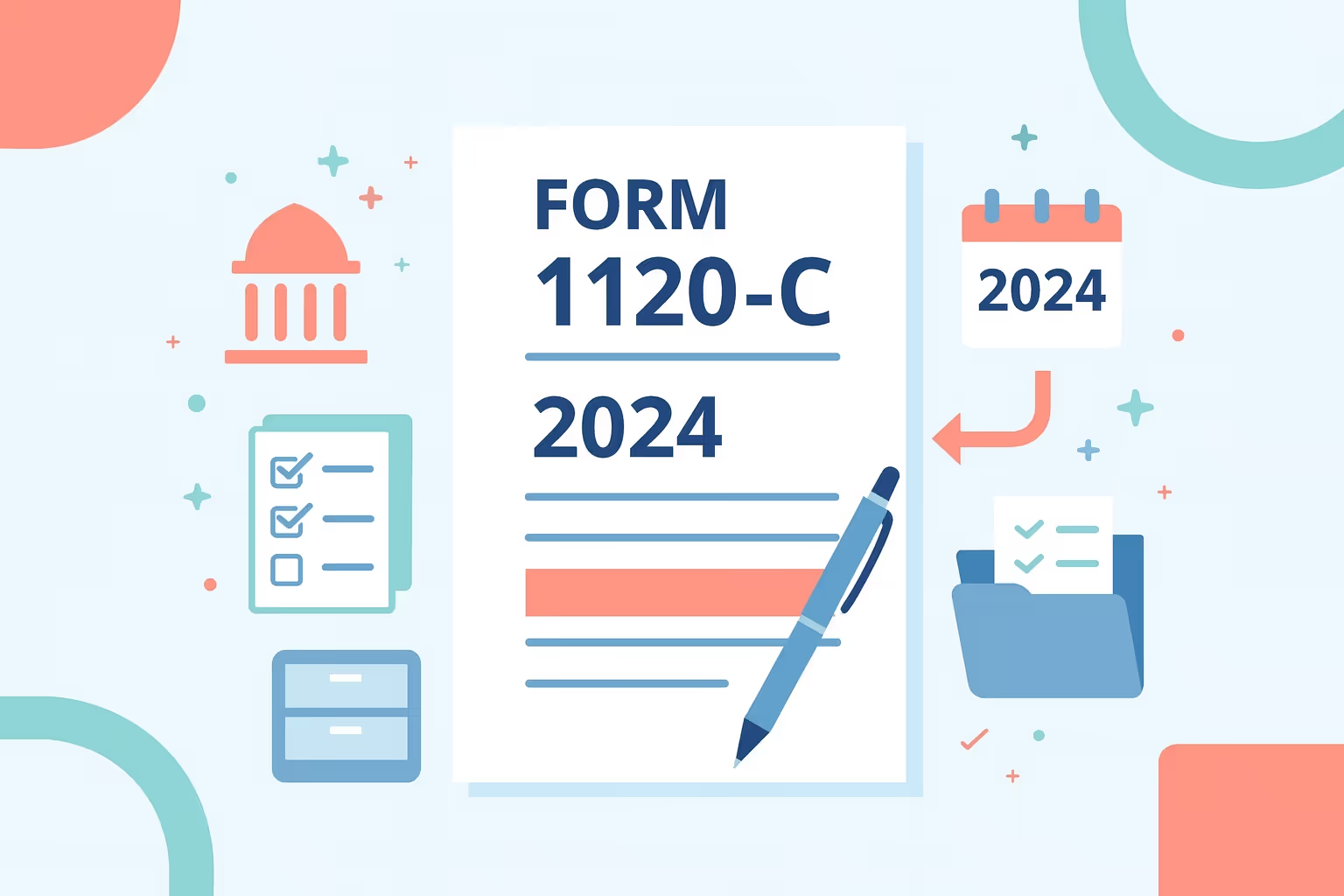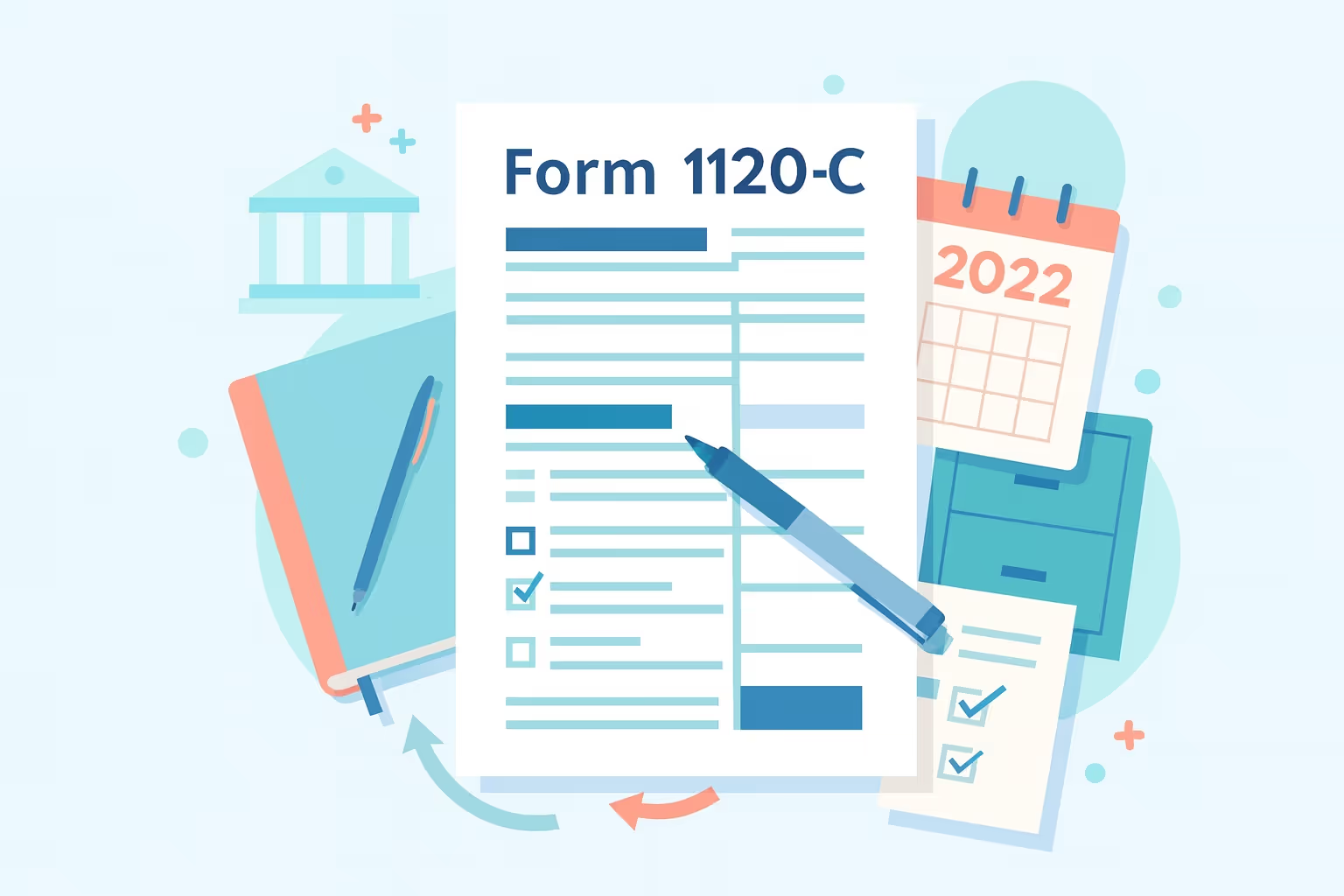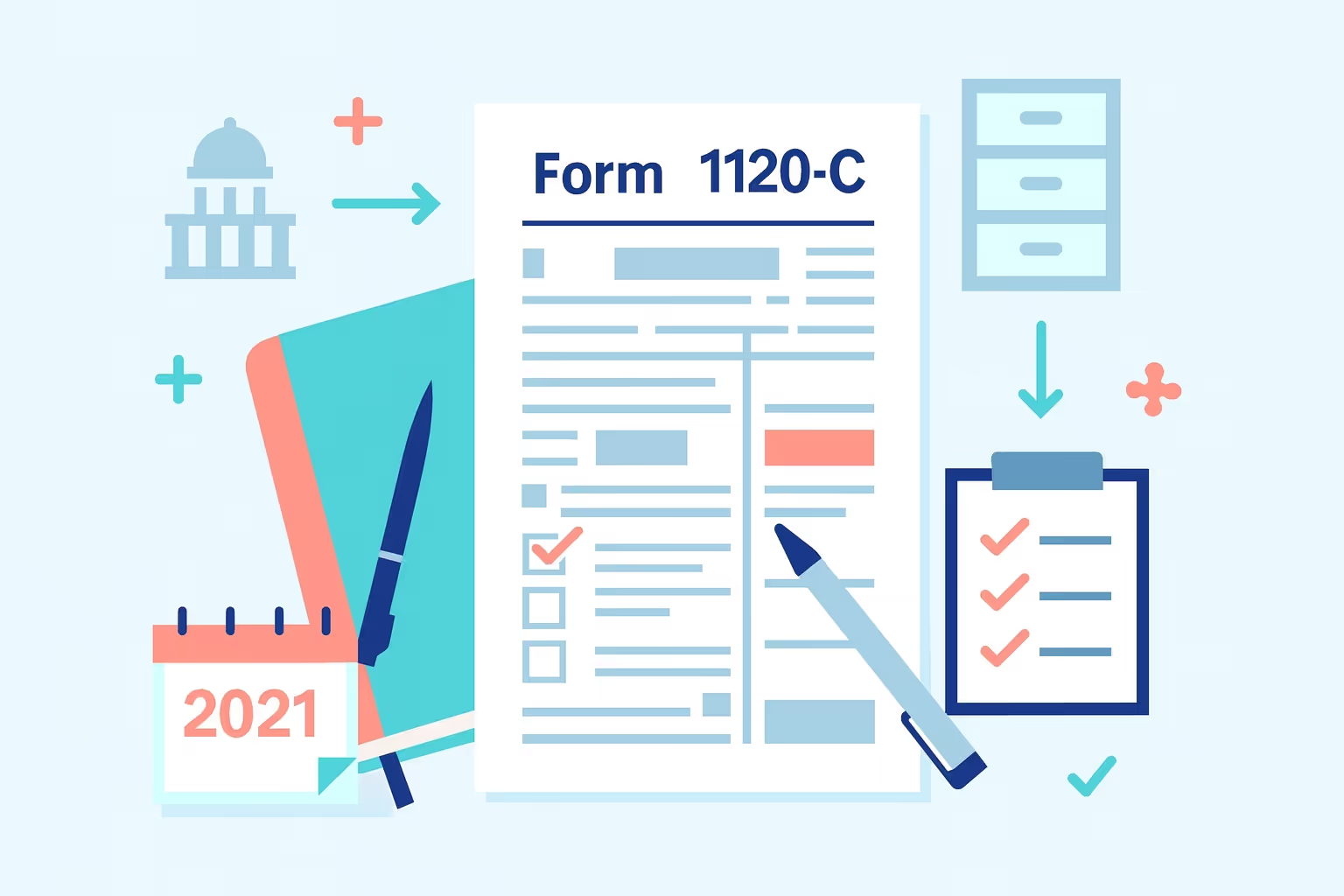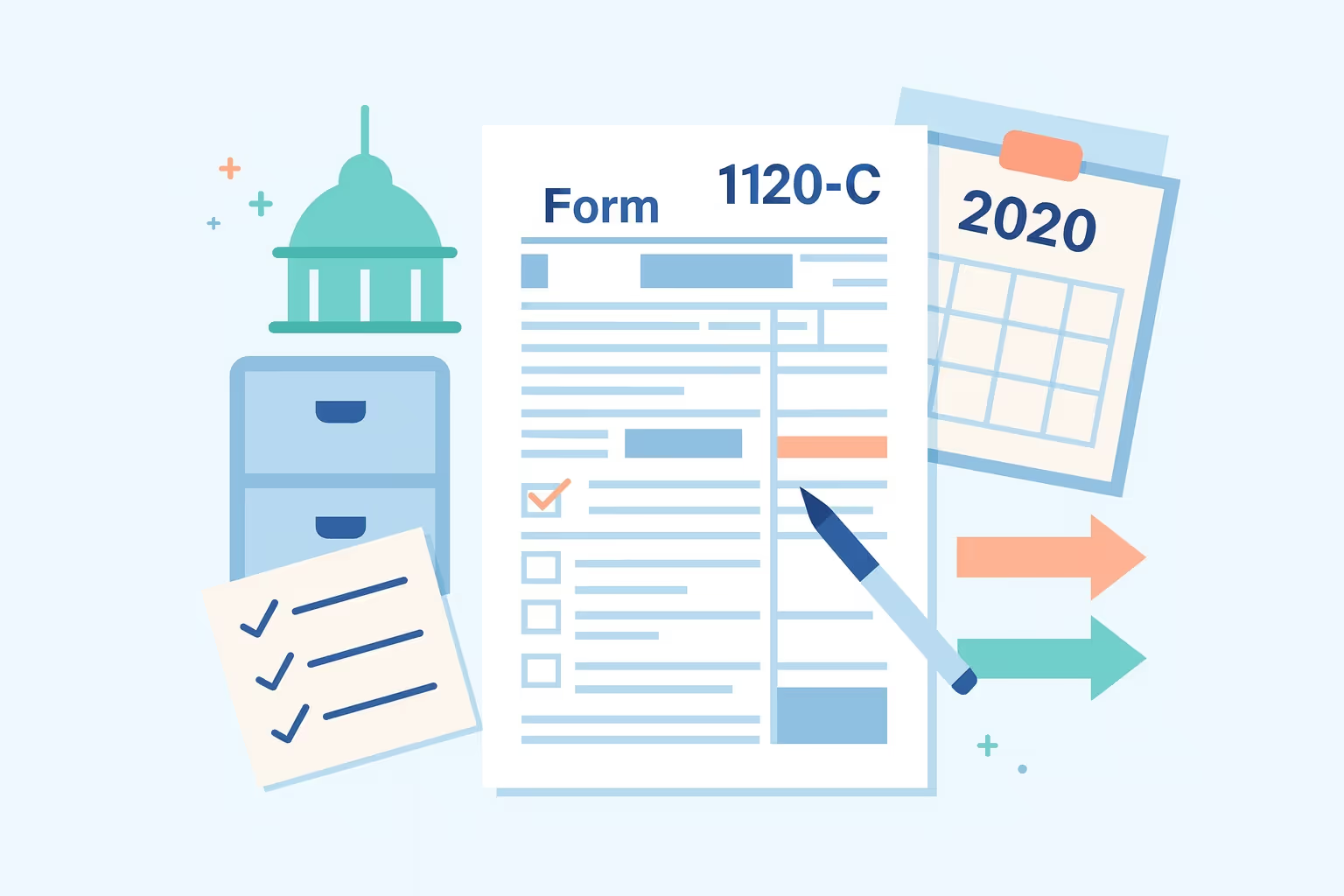Form 1120-C 2015 Instructions: How to File Step-by-Step
Form 1120-C 2015 instructions help cooperative associations understand how to properly report their income, deductions, and tax liabilities to the IRS. This form applies specifically to cooperatives operating under Subchapter T of the Internal Revenue Code, including farmers' cooperatives, marketing associations, and credit unions. The goal is to ensure each cooperative accurately files its income tax return, separates patronage and nonpatronage income, and remains compliant with federal regulations.
Form 1120-C offers comprehensive instructions on how taxpayers should submit their yearly returns, make payments, and claim qualified deductions for the 2015 tax year. The Electronic Federal Tax Payment System (EFTPS), which facilitates secure transactions directly from a cooperative's bank account, is one of the approved payment options outlined in these guidelines. To minimize errors, simplify operations, and expedite the management of business funds, the IRS places a strong emphasis on electronic filing and payment options.
Cooperatives can maintain their good standing with the Internal Revenue Service, avoid disputes, and avoid unnecessary fees or penalties by adhering to the proper filing procedures. Proper filing protects the cooperative and its members, regardless of whether the cooperative handles recurring billing through subscription services or takes payments from consumers. This manual provides precise and detailed instructions to help cooperatives and new businesses complete their 2015 filing.
What Is Form 1120-C?
Form 1120-C, U.S. Income Tax Return for Cooperative Associations, is the primary tax form used by cooperative organizations to report their income, deductions, gains, and credits to the IRS. It applies to organizations that function cooperatively under Internal Revenue Code Subchapter T. The form helps determine the accurate amount of tax due or reimbursed for the year and ensures compliance with federal income tax regulations.
Entities Required to File Form 1120-C
The following entities are required to file Form 1120-C:
- Farmers' cooperatives that are eligible for the Section 521 tax exemption and allocate profits to members according to their use.
- Cooperatives that function according to the cooperative principles outlined in Section 1381 are not exempt.
- Cooperatives that divide profits among members based on the volume of transactions in marketing and purchasing.
- Financial institutions that choose to be subject to cooperative association taxes.
- Other member-based organizations comply with IRS cooperative taxation requirements.
Purpose of Form 1120-C
Form 1120-C serves several key purposes:
- It is used to report annual income and compute the cooperative's total business tax liability for the year.
- It helps separate patronage and nonpatronage income to ensure accurate tax treatment and proper allocation of deductions.
- It allows cooperatives to claim eligible deductions and make secure payments using approved methods, such as EFTPS bank transfers.
- It ensures compliance with IRS reporting requirements and helps avoid penalties for underpayment or misreporting.
Filing Form 1120-C correctly helps cooperatives maintain transparency, protect business funds, and support recurring revenue activities such as member purchases and subscription services. Accurate filing also strengthens compliance, improves recordkeeping, and facilitates seamless tax management for growing organizations.
What's New for Tax Year 2015?
For the 2015 tax year, several updates affected how cooperative associations completed Form 1120-C. These changes aimed to simplify filing, improve reporting accuracy, and align cooperatives with modern payment and electronic filing systems.
Key updates included:
- Schedule M-3 Filing Threshold: Cooperatives with total assets of 10 million dollars or more at the end of the tax year were required to file Schedule M-3 (Form 1120) instead of Schedule M-1. This ensured better transparency in book-to-tax reconciliations.
- Electronic Filing Enhancements: The IRS encouraged more cooperatives to e-file their returns to reduce errors and processing delays. Although not mandatory for all filers in 2015, electronic filing was strongly recommended for organizations submitting multiple returns.
- EFTPS Payment Requirements: All cooperatives were required to make tax deposits through the Electronic Federal Tax Payment System. This method allowed secure transfers directly from the cooperative's bank account, improving payment tracking and reducing fraud risks.
- Domestic Production Activities Deduction: The Section 199 deduction remained available for eligible cooperatives, allowing them to claim tax relief on qualified production activities, provided proper allocation between patrons and the cooperative was documented.
These updates reflected the IRS's ongoing efforts to streamline cooperative tax filing, enhance payment security, and reduce operational complexity for organizations managing recurring revenue or subscription services.
Preparing to File Form 1120-C
Before filing Form 1120-C, cooperative associations must organize their financial information and verify that all required data aligns with IRS reporting standards. Proper preparation prevents errors, reduces processing time, and ensures that taxpayers can file accurately and on time.
Pre-Filing Checklist
Cooperatives should complete the following tasks before beginning the filing process:
- Gather financial records for the entire 2015 tax year, including income statements and balance sheets.
- Verify the Employer Identification Number (EIN) for accuracy.
- Compile records of all payments made to patrons or members.
- Separate patronage and nonpatronage income for correct reporting.
- Review prior-year filings to maintain consistency in reporting methods.
- Confirm access to the cooperative's bank account to make electronic payments through EFTPS.
- Verify that all payment details are accurate to prevent delays or disputes.
Key Forms and Resources
- Form 1120-C and its 2015 instructions are available at IRS.gov.
- Related schedules such as Schedule C (dividends and deductions), Schedule G (patronage income allocation), and Schedule M-3 (financial reconciliation).
- IRS publications offering additional guidance for cooperatives and taxpayers.
By being well-prepared, the cooperative can minimize management expenses and possible filing errors while integrating accurate data, choosing preferred payment methods, and submitting all necessary forms on time.
Step-by-Step Filing Instructions
Accurately filling out several crucial return sections is necessary when filing Form 1120-C. For income, deductions, and tax liabilities to be accurately reported, each line must be completed in accordance with IRS regulations.
Completing Page 1 – Basic Information and Income
- Lines A–D (Entity Information): Enter the cooperative's name, address, EIN, and type of entity (farmers' cooperative, nonexempt, or tax-exempt).
- Lines 1–10 (Income): Report gross receipts or sales, returns and allowances, and cost of goods sold. Subtract returns and allowances to determine gross profit. Include other income sources such as dividends, interest, and rental income.
- Lines 11–24 (Deductions): Record expenses such as officer compensation, wages, rents, taxes, licenses, and interest. Allocate these between patronage and nonpatronage income on Schedule G.
- Lines 25–33 (Tax Calculation): Use Schedule J to compute total tax liability. Include payments and credits, calculate any penalties, and determine the amount owed or refunded.
Allocating Patronage and Nonpatronage Income
Form 1120-C requires cooperatives to separate income earned from members (patronage) and nonmembers (nonpatronage). This allocation determines which deductions apply to which income source and ensures the cooperative follows Subchapter T rules. Proper allocation helps avoid disputes, supports transparency, and provides a clear picture of the organization's taxable activity.
Computing Tax Liability
The computation of the cooperative's overall income tax is the last phase. Cooperatives should record payments made using authorized payment methods, apply available credits, and calculate their tax rate using Schedule J. Because they lower the risk of fraud, facilitate safe fund transfers, and make payment tracking easier, electronic payments—like bank transfers made via EFTPS—are recommended.
Accurately completing these processes ensures that the cooperative files correctly, complies with IRS regulations, and maintains smooth financial management throughout its transactions and business operations.
Payment Instructions and EFTPS Requirements
For Form 1120-C tax payments, the Electronic Federal Tax Payment System (EFTPS) is the necessary platform. It enables cooperatives to use safe online techniques to move money directly from their bank accounts. For both the IRS and taxpayers, this system enhances payment tracking and reduces the risk of fraud.
Using the Electronic Federal Tax Payment System
- Register with EFTPS: Cooperatives must register through EFTPS.gov and provide their business bank account information.
- Receive PIN and Login Details: The IRS mails a Personal Identification Number (PIN) within several business days after registration is complete.
- Schedule Payments: Taxpayers can log in to schedule payments such as those for balance due, estimated tax, or recurring billing.
- Confirm Transactions: Each payment generates a confirmation number, which serves as proof of successful submission.
Avoiding Common Payment Errors
Cooperatives should check all payment information before submitting. Problems such as scheduling after the deadline, using the incorrect payment type, or entering the wrong tax periods are common. By 8:00 p.m. Eastern Time on the same day, payments made through the EFTPS system are processed. Planning avoids fines and guarantees that money is received on schedule.
Because it supports a variety of payment methods, including bank transfers, and contributes to the accuracy of payment records, EFTPS remains the IRS's preferred method of payment. Cooperatives can integrate digital wallets and online banking tools to facilitate fund transfers and enhance financial management.
Required Schedules and Attachments
A cooperative's operations must be detailed financially in several schedules and attachments required by Form 1120-C. Every schedule facilitates accurate reporting and helps the IRS confirm tax calculations, income distributions, and deductions.
Commonly Required Schedules
- Schedule C – Dividends and Special Deductions: Reports dividends received from other corporations and calculates allowable special deductions.
- Schedule G – Allocation of Patronage and Nonpatronage Income: Separates income from cooperative activities with members versus nonmembers.
- Schedule H – Distributions to Patrons: Lists payments, property distributions, and written notices of allocation.
- Schedule J – Tax Computation: Computes total income tax, credits, and adjustments.
- Schedule L – Balance Sheets: Shows beginning and end-of-year assets, liabilities, and retained earnings.
- Schedules M-1 and M-2 – Reconciliations: Compare book income to taxable income and track retained earnings.
- Schedule M-3 – Financial Reconciliation: Required for cooperatives with total assets of 10 million dollars or more.
Filing Considerations
Depending on their operations and size, smaller cooperatives might only finish pertinent schedules. The return must be filed electronically or by mail, accompanied by all attached schedules. To avoid processing delays, cooperatives should confirm that the amounts listed on the main form match the totals in the schedules.
Proper completion of these attachments guarantees accurate recording of all deductions and transactions, facilitates tax review, and helps maintain compliance.
Common Mistakes to Avoid
Errors in filing Form 1120-C can lead to penalties, delays, or disputes with the IRS. Many of these issues result from incomplete data, missed schedules, or inaccuracies in income allocation.
Frequent Filing Errors
- Incorrect Allocation of Income: Failing to separate patronage and nonpatronage income correctly on Schedule G can lead to inaccurate tax calculations.
- Missing Schedules: Omitting required attachments such as Schedule M-3 or Schedule H can delay return processing.
- Incorrect Entity Details: Errors in the cooperative's EIN, address, or name create verification problems with IRS systems.
- Mathematical Mistakes: Errors in addition or subtraction often occur in deductions and balance sheet totals.
- Late or Inaccurate Payments: Missing the due date or submitting incomplete payment details in EFTPS can result in penalties and additional fees.
- Missing Signatures: Unsigned forms are considered incomplete and may be rejected.
To prevent these issues, cooperatives should create a review checklist before filing and confirm that all entries match their financial records. Proper management of forms, payments, and schedules ensures smoother transactions and helps cooperatives maintain good standing with the IRS.
Filing for Zero Activity or Dormant Cooperatives
Even when a cooperative has little or no activity during the tax year, filing Form 1120-C is often still required. Submitting the form ensures the organization maintains its legal standing with the IRS and avoids penalties for non-compliance with filing requirements.
- A cooperative must file if it remains legally active, even if it has no sales or income. This requirement demonstrates continued compliance with IRS regulations.
- Filing is necessary when the cooperative earns any income, such as interest or minimal service fees, even if operations were limited.
- Cooperatives that wish to preserve prior losses or deductions must file to maintain eligibility for future tax benefits.
- The IRS may require a return even for inactive entities, and failure to respond to such a notice can result in penalties or loss of tax status.
- When filing, all entity information should be completed, with zeros entered for income lines and only actual expenses reported.
- Financial statements should be attached to show the cooperative's financial position and document its overall status for the filing year.
Filing for a dormant or inactive year keeps the cooperative's records up to date, supports transparency, and preserves the ability to utilize deductions or credits in future tax years. It also simplifies reactivation if business operations resume later.
First-Time Filer Tips
Filing Form 1120-C for the first time can feel overwhelming for new cooperatives that are still learning how to handle both income tax and member-based accounting. Following a transparent, organized process helps ensure accuracy and compliance with IRS requirements.
- Every cooperative must obtain an Employer Identification Number (EIN) before filing to ensure accurate identification with the IRS.
- Accounting software should be set up to record both patronage and nonpatronage income, making year-end reporting easier and more accurate.
- Registration with the Electronic Federal Tax Payment System allows cooperatives to make secure payments directly from their business bank account, thereby avoiding processing delays.
- All invoices, payment records, and previous tax documents should be gathered and reviewed before completing the form to prevent missing data.
- Payment information entered into EFTPS must be verified to ensure that funds are correctly scheduled, processed, and cleared by the due date.
- Seeking advice from a tax professional experienced in cooperative taxation helps new filers understand deductions, filing options, and documentation standards.
Careful preparation and organized recordkeeping help new businesses meet IRS standards, prevent payment disputes, and support long-term operational stability. Cooperatives that accept payments through bank transfers, digital wallets, or other preferred payment methods should make sure their systems integrate securely with their financial and tax reporting processes.
Frequently Asked Questions
What is the Form 1120-C 2015?
The Form 1120-C 2015 instructions guide cooperative associations on how to accurately and efficiently report income, deductions, and payments to the IRS. These directions help taxpayers file correctly, avoid penalties, and comply with income tax laws. They explain how to complete each section of the form, make secure payments from a business bank account, and include all required schedules, including income statements, deductions, and patronage allocations for cooperatives.
Can cooperatives accept multiple payment methods when filing or collecting payments?
Cooperatives can accept multiple payment methods to simplify transactions with members and customers. Accepted options include bank transfers, digital wallets, and cash-based vouchers. Using preferred payment methods such as Apple Pay, Google Pay, or WeChat Pay supports better fund management and enhances the checkout experience. Providing flexible payment options also improves customer loyalty and supports recurring billing for ongoing cooperative services.
What is the best payment method for IRS filings and cooperative transactions?
For IRS-related payments, bank transfers made through the Electronic Federal Tax Payment System are preferred because they are secure and provide a clear audit trail. However, when accepting payments from customers, businesses may use multiple payment methods tailored to customer preferences. Examples include credit or debit cards, digital wallets, or cash for local transactions. Each technique helps cooperatives manage money flow while reducing fraud and transaction costs.
How do digital wallets and online payment options improve cooperative management?
Digital wallets, such as Apple Pay, Google Pay, and WeChat Pay, enable cooperatives to accept payments securely, instantly, and across multiple countries. These payment options simplify transactions by automating recurring billing, enhancing recurring revenue management, and ensuring funds are deposited into the correct business account. Integrating digital wallets into daily operations enhances customer loyalty, supports diverse payment preferences, and creates a smoother checkout experience for both taxpayers and consumers.
How do cooperatives manage recurring revenue and subscription services?
Cooperatives that operate on recurring billing or subscription-based business models can streamline income tracking by automating payment schedules through EFTPS or digital payment platforms. Integrating systems that support multiple payment methods reduces costs, maintains accurate payment details, and enhances the customer experience. This approach promotes customer retention and simplifies accounting for recurring transactions and deductions.















